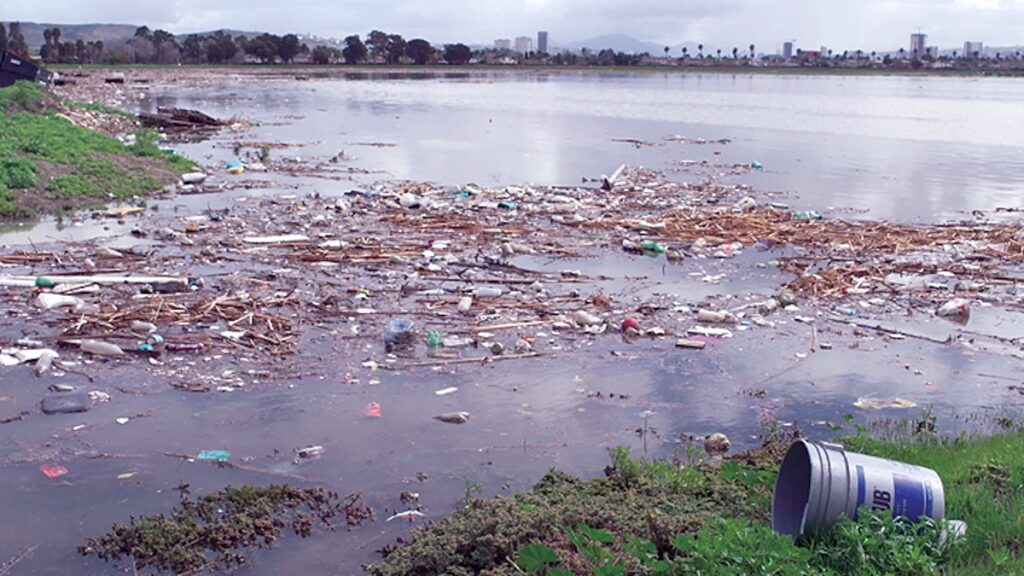Raw Sewage in Tijuana River at Mexico-U.S. Border a ‘Public Health Crisis’
5 min read
February’s severe weather flooded San Diego County’s Tijuana River Valley at Dairy Mart Road near the international border. Researchers from SDSU found that the contaminated runoff can become airborne and linger in soils, further impacting public health. Photo courtesy of Prebys Foundation
Founded in 2005 as an Ohio-based environmental newspaper, EcoWatch is a digital platform dedicated to publishing quality, science-based content on environmental issues, causes, and solutions.
Runoff and raw sewage in the Tijuana River at the Mexico-United States border is exposing communities to a noxious mixture of toxic chemicals and microbes, a new report by researchers with the School of Public Health at San Diego State University (SDSU) said.
The contaminated river flows from Mexico into South San Diego, bringing industrial waste, untreated sewage and urban run-off that can linger in soils and become airborne, potentially creating widespread environmental health impacts, according to a press release from SDSU.
Congressperson Scott Peters requested the report be commissioned by the Conrad Prebys Foundation.
“This environmental catastrophe has hurt the region for many years, resulting in decades of adverse health consequences,” Peters said in the press release. “We must approach it as a health and national security concern, which is why I asked the Prebys Foundation to help me build the case that this crisis goes far beyond beach closures; the people of South Bay now endure constant toxic air pollution that damages their health and well-being.”
The U.S. Clean Water Act has classified the Tijuana River and Estuary (TJRE) as “an impaired water body,” the study said.
The researchers looked at more than 60 studies and reports that examined public health and environmental concerns related to the TJRE, the press release said.
More than 100 billion gallons of industrial waste, untreated sewage and urban runoff have been discharged into the Tijuana Estuary by way of the Tijuana River and tributaries — eventually making their way to the Pacific Ocean — over the past five years, according to the International Boundary and Water Commission.
The contamination has caused beaches to be closed for more than 700 consecutive days, greatly affecting visitors, local residents and economies. Additionally, U.S. Navy personnel, lifeguards, first responders and border patrol agents are faced with hazardous occupational health exposures.
“This is not a trickle of contamination,” said Paula Stigler Granados, lead author of the paper and an associate professor with the School of Public Health at SDSU, as The Guardian reported. “This is a large amount of contamination over a long period of time.”
The report said the pollution poses threats to the health of vulnerable groups like seniors, children, outdoor workers, pregnant women and other special populations. The polluted waters have been found to contain serious pathogens like antibiotic-resistant bacteria, which were believed to have been eradicated in California.
The findings prompted further investigations by SDSU researchers to gain a better understanding of the impacted communities’ public health exposure risk.
The report pointed out that area infrastructure could be further degraded and issues exacerbated by climate change and the resulting increased intensity of storms.
“There needs to be more research done to fully understand the extent of the risks posed by exposure to these dangerous contaminants,” Granados said in the press release. “Urgent interventions are needed to help reduce and address both the immediate and long-term potential health repercussions to those living near this hazardous environment.”
Paloma Aguirre, mayor of Imperial Beach, has called for the California Department of Public Health, San Diego County and the Centers for Disease Control and Prevention to get involved and actively monitor the situation, as well as any public health concerns related to the sewage.
“Imperial Beach is unfortunately the poster child of what an environmental injustice looks like,” Aguirre said, as reported by The Guardian.
Aguirre has collaborated with the University of California, San Diego School of Medicine and SDSU’s School of Public Health to create a task force in recent months.
“The persistent health impacts greatly reduce the quality of life for the community,” Aguirre said. “It’s a challenging task, but now is the moment to ensure that our elderly, our children, and water enthusiasts are not exposed to heightened health hazards while simply trying to enjoy a sunny day. Tackling this problem promptly and effectively is essential, as it is closely linked to the health and well-being of South Bay communities. The residents of Imperial Beach are worthy of far more than what they have been handed down.”
It is also an environmental justice issue, the researchers said, since the often economically limited border communities are already dealing with an increased threat of chronic disease, potentially placing them at higher risk of having complications from the environmental hazards posed by the contamination.
These same border communities are also facing increases in pollution from other sources like idling vehicles at border crossings. Additionally, they are no longer able to access healthy outdoor spaces, since the beach and ocean are contaminated.
“This study confirms what should be obvious, which is that San Diego’s health and community well-being are being seriously and actively harmed by years of inaction on this issue,” said Grant Oliphant, CEO of the Prebys Foundation, in the press release. “The good news is that it is fixable, and that leaders like Representative Peters and Mayor Aguirre and organizations like SDSU’s School of Public Health are working to make that happen. Their efforts deserve broad support, because public health in our region depends on a robust shared commitment to protecting everyone in every one of our communities from these sorts of preventable harms.”
Subscribe to get exclusive updates in our daily newsletter!
By signing up, you agree to the Terms of Use and Privacy Policy & to receive electronic communications from EcoWatch Media Group, which may include marketing promotions, advertisements and sponsored content.





